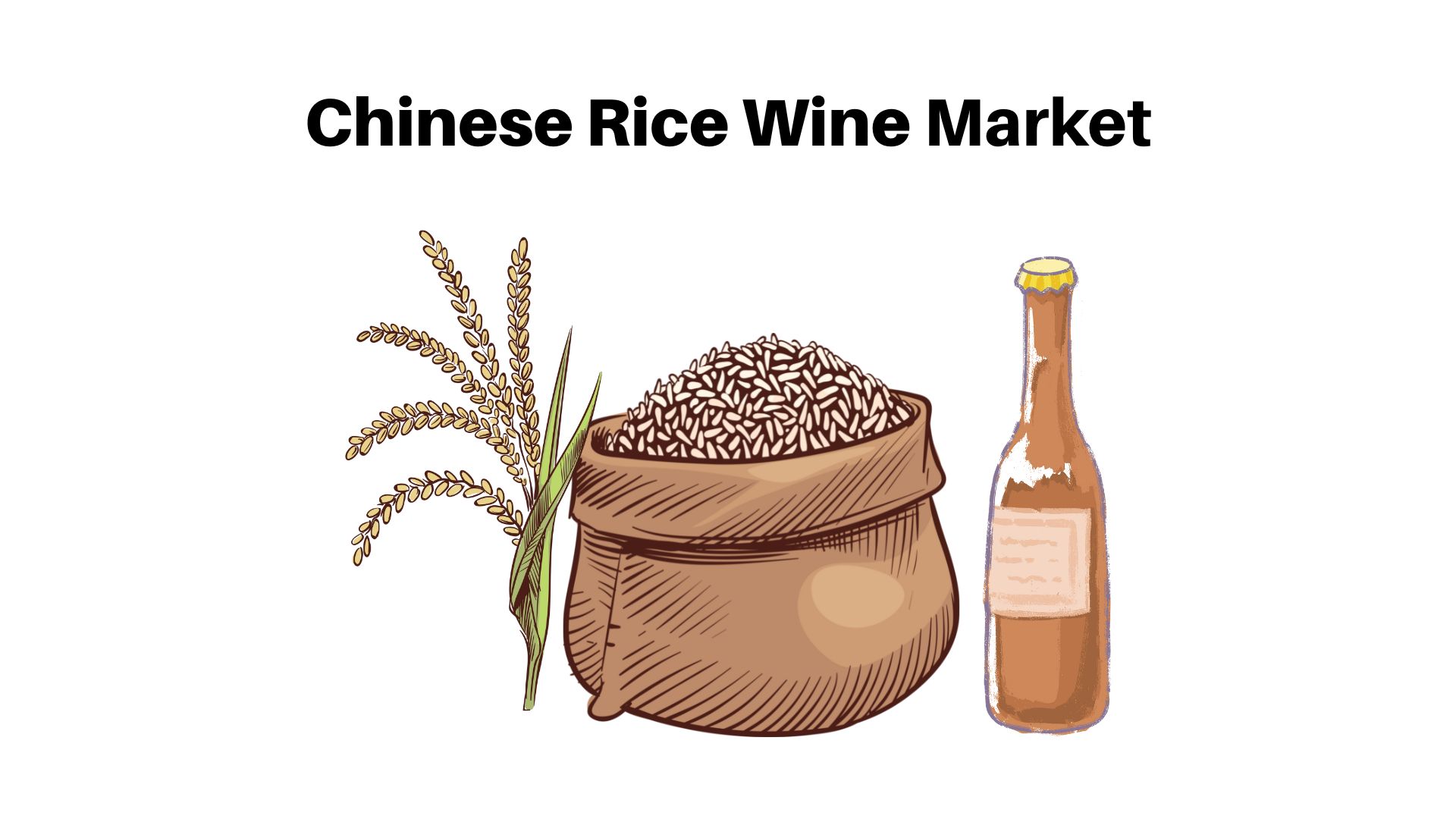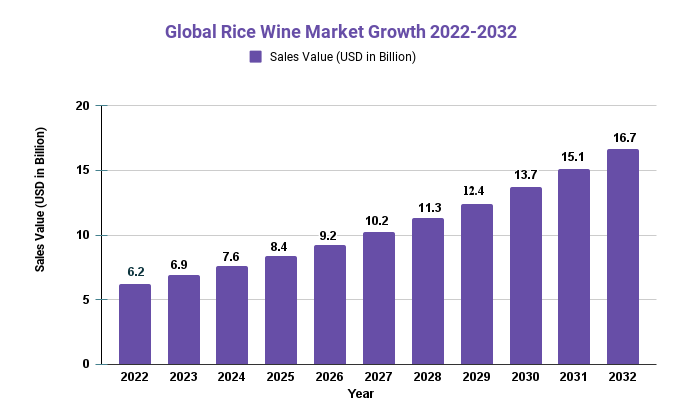Chinese Rice Wine Market Size USD 16.7 Bn by 2032| at a CAGR 10.4%

Page Contents
Market Overview
Published Via 11Press: The Chinese Rice Wine Market is one of the fastest-growing alcohol markets worldwide. Rice wine, also known as huangjiu or yellow wine, has a long and storied history in China; it's been enjoyed by Chinese people for thousands of years. Made from fermented glutinous rice, this traditional alcoholic beverage has a unique flavor and aroma.
Chinese Rice Wine Market was valued at USD 6.2 Bn in 2020 and is projected to reach a value of USD 16.7 Bn by 2025, growing at an annual compound growth rate (CAGR) of 10.4% during the forecast period.
This growth can be attributed to factors such as changing lifestyles, rising disposable incomes, and increasing demand for premium and high-quality rice wine.
The market is dominated by a few major players, such as Kweichow Moutai, Yanghe Brewery, Wuliangye and Luzhou Laojiao. These companies hold the majority of the market share and invest heavily in research and development to enhance their products' quality and taste.
Premium rice wine demand is on the rise, buoyed by a growing middle class and their willingness to invest in higher-quality goods. Furthermore, international consumers' growing fascination with Chinese cuisine and culture is driving demand for Chinese rice wine.

Drivers, trends, and challenges have an impact on market dynamics, which can impact businesses. Request for PDF sample report
Key Takeaways
- The Chinese rice wine market is projected to experience steady growth over the coming years due to rising disposable income, changing drinking habits, and an increase in demand for premium and specialty rice wines.
- Traditional-style rice wine remains the dominant category, though there is growing interested in modern-style wines, particularly among younger consumers.
- E-commerce platforms have become an important sales channel for rice wine sales, with online sales accounting for a substantial share of the market share.
- Domestic brands remain the dominant force in this market, but international players are steadily making inroads and are expected to gain a share over the coming years.
Regional Snapshot
- The eastern region of China, comprising Shanghai and Zhejiang provinces, is the leading market for rice wine in China, accounting for over 40% of total consumption.
- The central region, including Hunan and Hubei provinces, is a significant market with a longstanding tradition of producing high-quality rice wines.
- Guangdong and Fujian provinces in the south offer an array of rice wine styles such as sweet or fruity varieties.
- The northern region, including Beijing and Hebei province, favors dry, strong-flavored rice wines which can be enjoyed alongside meals.
- Western regions like Sichuan and Yunnan provinces have a long tradition of producing rice wine with distinct regional styles.
Drivers
- Growing Demand for Premium and Specialty Rice Wines: As Chinese consumers become wealthier, they are increasingly seeking out higher-quality items – such as premium and specialty rice wines.
- Changing Drinking Habits: There is a growing trend towards healthier and lower-alcohol beverages, which has driven demand for rice wine as it is seen as a healthier alternative to other alcoholic drinks.
- Rising disposable income: China's increasing levels of disposable income have spurred consumer spending on luxury and high-end items, such as rice wine.
- Growing Tourism Industry: China's expanding tourism industry presents new opportunities for the rice wine market, as more tourists seek out local and authentic items during their trips.
Restraints
Chinese government regulations regarding alcohol production and marketing could restrict the growth of the rice wine market.
- Limited Consumer Awareness: Rice wine is a traditional beverage in China, yet its popularity outside the country remains limited, potentially restricting export opportunities for domestic producers.
- Intense Competition: The Chinese rice wine market is highly competitive, with many domestic and international players competing for market share.
- Fluctuating prices of raw materials: Prices for key raw materials used in rice wine production, such as rice and yeast, may shift drastically due to fluctuations in supply. This could significantly impact the profitability of producers of this beverage.
Opportunities
- Growing Exports: Chinese rice wine is seeing an uptick in interest abroad, providing domestic producers with a chance to expand their customer base and boost exports.
- Innovation and Product Development: Rice wine producers have an opportunity to innovate and create new products in response to shifting consumer preferences and trends, such as low-alcohol or flavored rice wines.
- Online Sales: E-commerce platforms have become an important selling channel for rice wine, as more consumers are shopping online. This presents producers with the chance to expand their reach and access new markets.
- Tourism Industry: China's expanding tourism industry provides rice wine producers with an opportunity to reach out and market their products as authentic and local.
Challenges
- Growing Competition: The Chinese rice wine market is becoming increasingly competitive, with both domestic and international players competing for market share. This could make it difficult for new entrants to gain traction in the sector.
- Consumer Preferences and Drinking Habits Alter: Consumer preferences and drinking habits are evolving, potentially impacting the demand for rice wine. Producers must adjust to these new trends in order to remain competitive.
- Regulatory Challenges: The Chinese government has implemented more stringent regulations regarding alcohol production and marketing, potentially hindering the growth of the rice wine market.
- Rice wine still lacks widespread consumer awareness: Despite being a traditional beverage in China, rice wine remains little-known outside the country. Producers must invest in marketing and promotion to raise consumer awareness and boost demand.
Recent Developments
- In 2020, China's rice wine industry experienced a sudden surge in demand due to the COVID-19 pandemic as consumers sought out locally produced and traditional items.
- Chinese e-commerce giant JD.com launched the “Rice Wine Festival” in 2020 to support and promote the industry and domestic producers.
- In 2021, the China Alcoholic Drinks Association issued new guidelines for the production and marketing of rice wine that sought to enhance quality and safety standards.
- In 2021, Pernod Ricard announced their plans to enter the Chinese rice wine market with a premium brand.
Key Market Segments
Type
- Glutinous Rice Wine
- Millet Rice Wine
- Red Kojic Rice Wine
- Rice Wine
Application
- Commercial Use
- Home Use
Key Market Players
- China Shaoxing Yellow Wine Group Corp
- Kuaijishan
- Jinfeng Wine
- PAGOOA
- Nuerhong
- Jimo
- Jiashan
- Shazhou
- Shanhao
- Guyueloutai
Report Scope
| Report Attribute | Details |
| The market size value in 2022 | USD 6.2 Bn |
| Revenue forecast by 2032 | USD 16.7 Bn |
| Growth Rate | CAGR Of 10.4% |
| Regions Covered | North America, Europe, Asia Pacific, Latin America, and Middle East & Africa, and Rest of the World |
| Historical Years | 2017-2022 |
| Base Year | 2022 |
| Estimated Year | 2023 |
| Short-Term Projection Year | 2028 |
| Long-Term Projected Year | 2032 |
Frequently Asked Questions
Q: What is Chinese rice wine?
A: Chinese rice wine is an alcoholic beverage made from fermented rice. It is a traditional beverage in China and is consumed in a variety of settings, from family meals to formal banquets.
Q: What are the different types of Chinese rice wine?
A: There are two main categories of Chinese rice wine: traditional-style rice wine, which is fermented from glutinous rice using a natural yeast starter, and modern-style rice wine, which is fermented from non-glutinous rice using cultivated yeast.
Q: How is Chinese rice wine served?
A: Chinese rice wine is typically served at room temperature or slightly warmed. It is often consumed as an aperitif or digestif, or served alongside meals.
Q: Is Chinese rice wine gluten-free?
A: Traditional-style Chinese rice wine is generally gluten-free, as it is made from glutinous rice, which does not contain gluten. However, modern-style rice wines may contain gluten, as they may be made from non-glutinous rice that has been mixed with wheat or other grains.
Q: How is a Chinese rice wine made?
A: Chinese rice wine is made by fermenting cooked rice with yeast and water. The fermentation process can take anywhere from a few weeks to several years, depending on the desired style and flavor of the wine.
The team behind market.us, marketresearch.biz, market.biz and more. Our purpose is to keep our customers ahead of the game with regard to the markets. They may fluctuate up or down, but we will help you to stay ahead of the curve in these market fluctuations. Our consistent growth and ability to deliver in-depth analyses and market insight has engaged genuine market players. They have faith in us to offer the data and information they require to make balanced and decisive marketing decisions.



